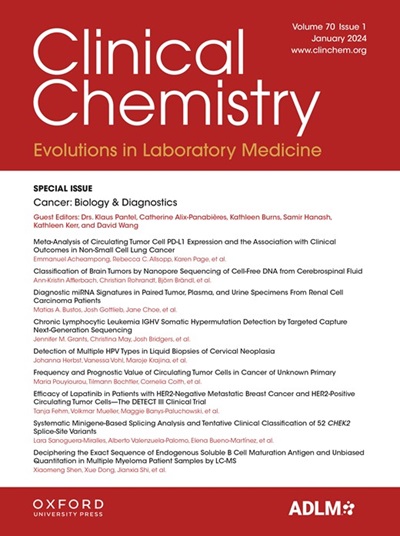A-064 使用富含黄酮类的药用植物山柰(Kaempferia parviflora)处理高级糖化终产物(AGEs)诱导的 RIN-m5F 胰岛β细胞,提高其胰岛素产量
IF 7.1
2区 医学
Q1 MEDICAL LABORATORY TECHNOLOGY
引用次数: 0
摘要
背景 高级糖化终产物(AGEs)是与还原糖发生反应的糖化蛋白质,会破坏胰岛素瘤细胞中胰岛素分泌的功能和细胞信号。AGEs 还会导致高血糖诱发 2 型糖尿病患者的胰岛素抵抗。AGEs 在长期高血糖状态下逐渐形成,是危害 β 细胞功能和存活的主要危险因素,并可改变胰岛素信号传导,下调胰岛素反应转录因子,包括 PDX-1、Glut-2、GCK 和 Pre-INS。山奈又名黑姜,是一种富含类黄酮的药用植物,对 2 型糖尿病患者有益,因为它能抵消 AGEs 的有害影响,并改善胰岛β细胞的胰岛素分泌。因此,我们推测,用最有效的含黄酮类的植物 K. parviflora 处理胰岛β细胞,可防止 AGE 诱导的胰岛素损伤,这些作用也是改善胰岛β细胞胰岛素合成和重要转录因子的原因。方法 将大鼠胰岛β细胞系 RIN-m5F (ATCC CRL-2058)置于含 10%(体积分数)FBS、1% 青霉素-链霉素的 RPMI 1640 培养基中,在 37 oC、含 5% CO2 的湿润环境中维持和培养。将 RIN-m5F 细胞用浓度为 0、25 和 50 µg/ml 的 K. parviflora 预处理 48 小时,然后暴露于 250 µg/ml AGEs 处理中。为了量化西番莲的生物活性化合物,进行了总酚和类黄酮含量检测,并使用实时 qRT-PCR 法检测了胰岛素相关基因(PDX-1、Glut-2、GCK 和 Pre-INS)的转录变化。结果 K. parviflora 的酚含量和类黄酮含量较高,分别为 50.43 ± 1.74 和 26.66 ± 1.18 mg GAE/g(样品干重)。在胰岛素相关基因的转录变化方面,暴露于 AGEs 处理后,胰岛素分泌通路调节因子(PDX-1、Glut-2、GCK 和 Pre-INS)的基因表达水平显著下调,而 K. parviflora 的预处理则显示出统计学差异。经 50 µg/ml K. parviflora 预处理后,PDX-1、Glut-2、GCK 和 Pre-INS 的表达明显上调。然而,与对照组(未处理)相比,在单独使用 AGEs 处理的条件下,转录水平明显下降。综上所述,这些结果表明,K. parviflora 可作为一种潜在的天然药物,用于改善 AGEs 诱导的 β 细胞损伤对胰岛素分泌的破坏,并突出了糖尿病治疗途径的前景。结论 用一种富含类黄酮的药用植物 K. parviflora 处理 RIN-m5F 胰岛 β 细胞,可以上调胰岛素反应转录因子,改善 AGE 诱导的胰岛 β 细胞损伤中的胰岛素分泌。我们的研究结果提供了一种与代谢性疾病相关的新策略,并深入揭示了将西洋金花作为治疗 2 型糖尿病的药物对胰岛素合成的调控作用。本文章由计算机程序翻译,如有差异,请以英文原文为准。
A-064 Improved Insulin production in Advanced glycation end-products (AGEs)-induced RIN-m5F pancreatic β-cells by using a Flavonoid-Rich Medicinal Plant, Kaempferia parviflora treatment
Background Advanced glycation end-products (AGEs) are glycated proteins that react with reducing sugar which causes the damages of function and cellular signaling of insulin production in insulinoma cells. AGEs also contribute to hyperglycemia-induced insulin resistance in type 2 diabetes. AGEs gradually form during the chronic high blood glucose condition, which is a major risk factor and harmful to β-cells function and survival, and could alter the insulin signaling and downregulate the insulin-responsive transcription factors including PDX-1, Glut-2, GCK, and Pre-INS. Kaempferia parviflora, also known as black ginger and flavonoid-rich medicinal plant, has beneficial properties for type 2 diabetes patients as a counteracts the detrimental effects of AGEs and improves the insulin production in pancreatic β-cells. Thus, we hypothesize that treated β-cells with K. parviflora, which is the most effective flavonoid-containing plant might protect against the damage of AGEs-induced insulin impairment, and these effects are also responsible for improved insulin synthesis and the essential transcription factors in pancreatic β-cells. Methods Rat pancreatic β-cell line RIN-m5F (ATCC CRL-2058) were maintained and cultured in RPMI 1640 medium containing 10% (v/v) FBS, 1% penicillin-streptomycin at 37◦C in a humidified atmosphere containing 5% CO2. RIN-m5F cells were pre-treated with the K. parviflora at concentrations 0, 25, and 50 µg/ml for 48 hours, and afterward, exposure to 250 µg/ml AGEs treatment. To quantify the bioactive compound of K. parviflora, total phenolic and flavonoid content assays were performed and the transcriptional changes of insulin-related genes (PDX-1, Glut-2, GCK, and Pre-INS) were determined by using real-time qRT-PCR. Results K. parviflora has shown a high phenolic content and flavonoid content was 50.43 ± 1.74, 26.66 ± 1.18 mg GAE/g Dry weight of sample, respectively. For the transcriptional changes of insulin-related genes, the levels of gene expression in the regulators of insulin secreting pathway (PDX-1, Glut-2, GCK, and Pre-INS) were significantly downregulated after exposure to AGEs-treated, while the pre-treatment of K. parviflora was showed statistically difference. PDX-1, Glut-2, GCK, and Pre-INS expressions were significantly upregulated after pre-treated with 50 µg/ml K. parviflora. However, under the AGEs-treated alone condition, the transcriptional levels were significantly decreased as compared to the control (untreated). Taken together, these results suggest K. parviflora could be a potential natural medicine to ameliorate the damage of insulin production in AGEs-induced β-cell damage and highlight promising alternatives for therapeutic avenue against diabetes. Conclusions Treated RIN-m5F pancreatic β-cells with K. parviflora, a flavonoid-rich medicinal plant, could upregulate the insulin-responsive transcription factors and improve the insulin production in damaging AGEs-induced pancreatic β-cells. Our findings provide a novel strategy related metabolic disease and insights into the regulation of insulin synthesis by using K. parviflora treatment as a therapeutic agent against type 2 diabetes.
求助全文
通过发布文献求助,成功后即可免费获取论文全文。
去求助
来源期刊

Clinical chemistry
医学-医学实验技术
CiteScore
11.30
自引率
4.30%
发文量
212
审稿时长
1.7 months
期刊介绍:
Clinical Chemistry is a peer-reviewed scientific journal that is the premier publication for the science and practice of clinical laboratory medicine. It was established in 1955 and is associated with the Association for Diagnostics & Laboratory Medicine (ADLM).
The journal focuses on laboratory diagnosis and management of patients, and has expanded to include other clinical laboratory disciplines such as genomics, hematology, microbiology, and toxicology. It also publishes articles relevant to clinical specialties including cardiology, endocrinology, gastroenterology, genetics, immunology, infectious diseases, maternal-fetal medicine, neurology, nutrition, oncology, and pediatrics.
In addition to original research, editorials, and reviews, Clinical Chemistry features recurring sections such as clinical case studies, perspectives, podcasts, and Q&A articles. It has the highest impact factor among journals of clinical chemistry, laboratory medicine, pathology, analytical chemistry, transfusion medicine, and clinical microbiology.
The journal is indexed in databases such as MEDLINE and Web of Science.
 求助内容:
求助内容: 应助结果提醒方式:
应助结果提醒方式:


